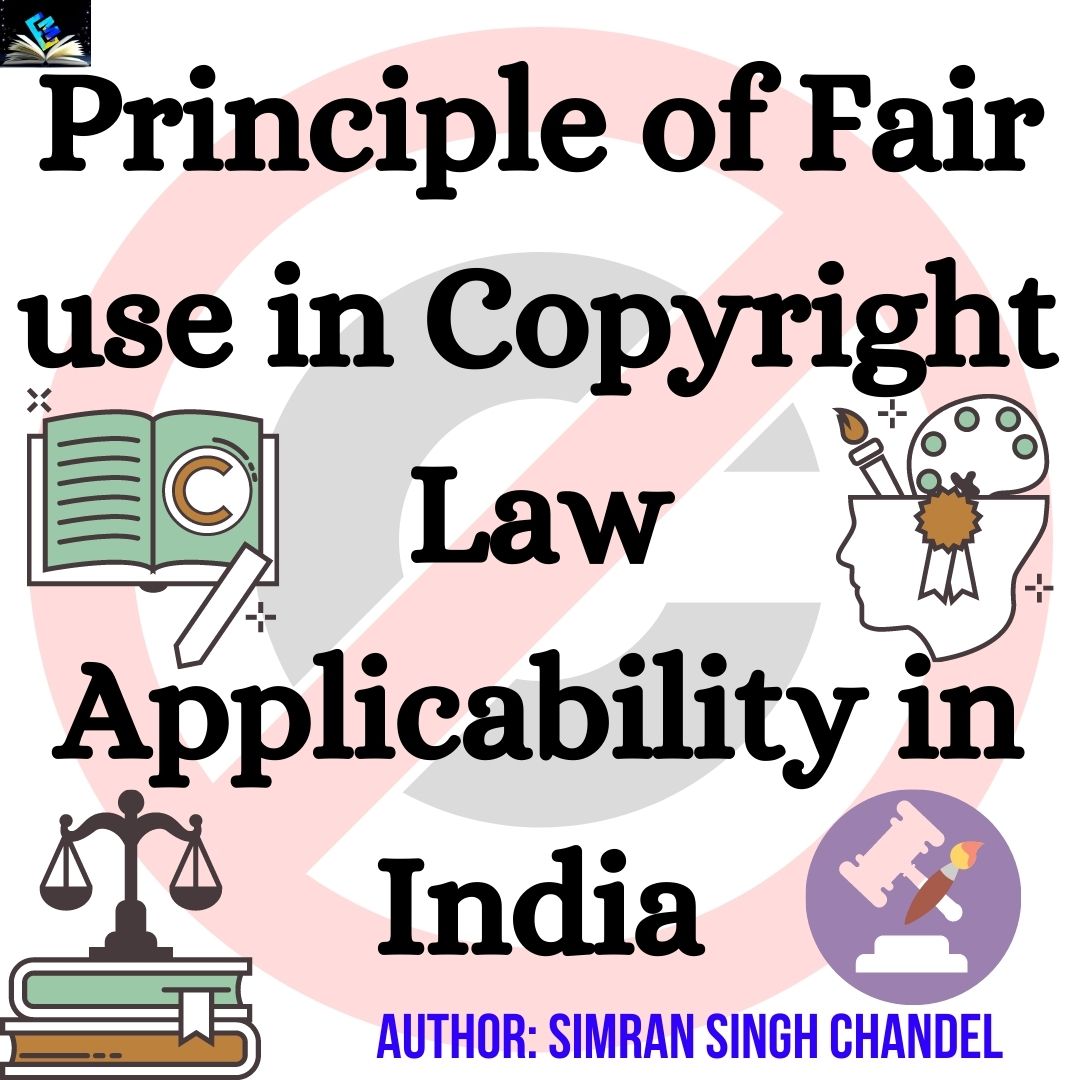
Principle of Fair use in Copyright Law | Applicability in India
Keywords:- Copyright, Fair use, Author, Work
Author – Simran Singh Chandel
INTRODUCTION:
Copyright implies that only the original creators or producers of a brand or commodity, as well as anybody they permit to, have the sole right to replicate the work. The main or original owner of the product gives the right to use their original product, as a franchise. There are numerous laws pertaining to protection of copyright products. Any person or company found reproducing or replicating original copyright protected-product without taking permission of the original owner of the product will suffer consequences of law under the Copyright Act, 1957.
COPYRIGHT IN INDIA:
In the case of unique or original literary, dramatic, musical and artistic or inventive works, the period of copyright is the life of the writer or artist, and 60 (sixty) years counted from the year following the loss of life of the writer. The Copyright Act, 1957 (the ‘Act’) came into effect in January 1958. The Act has been amended five times since then, i.e., in 1983, 1984, 1992, 1994, 1999 and 2012. The Copyright (Amendment) Act, 2012 is the most substantial.
The main reasons for amendments to the Copyright Act, 1957 include bringing the Act in conformity with two WIPO internet treaties concluded in 1996 namely, the WIPO Copyright Treaty (“WCT”) and WIPO Performances and Phonograms Treaty (“WPPT”);
- to protect the Music and Film Industry and address its concerns;
- to address the concerns of the physically disabled and to protect the interests of the author of any work;
- Incidental changes;
- to remove operational facilities;
- and enforcement of rights.
Some of the important amendments to the Copyright Act in 2012 are an extension of copyright protection in the digital environment such as penalties for circumvention of technological protection measures and rights management information, and liability of internet service provider and introduction of statutory licenses for cover versions and broadcasting organizations; ensuring the right to receive royalties for authors, and music composers, exclusive economic and moral rights to performers, equal membership rights in copyright societies for authors and other right owners and exception of copyrights for physically disabled to access any works.
Categories of the Copyright Work:-
- Literary Works (referring to original literary work such as article, blog, books, paper, script, research work etc.)
- Dramatic works (referring to plays, short movies, short acts, acting, drama etc.).
- Artistic works (referring to paintings, sculptures, drawings, photography, charts, photography, charts).
- Musical works (referring to songs, music).
- Cinematograph Films & Sound recordings.
Principle of fair use of copyright in India:
The main principles of fair use of the copyright are Copyright law in India applies to all original and innovative creations. Materials ranging from magazines, books, photos, music, sound recordings, artwork, websites and the like are protected by copyright law. In addition, the choreography, architecture, choreography is also reinforced. When a person can view, examine, or listen to content, it is most likely protected under copyright guidelines. To protect the work, no notice or copyright registration is required. It can also be done without these. The author’s original works are protected by copyright law. When a work is created through any means, that work is automatically protected by copyright.
Author of the Work
The author in the case of literary or dramatic content is the person who develops the content. A composer is the author of a musical work. In a motion picture, the producer is the author. The producer is the legal owner of the sound recording. The photographer is the author and owns the property in the case of a photograph. The person responsible for creating computer-generated content is the author. Copyright security in original content lasts for many years.
An author’s work can be protected for as long as the author’s life is, and after his death, the work is protected for another seventy years. However, where some content is not protected by copyright, it can be used without any legal obligations or restrictions under copyright law. However, copyright has an expiration date and these works can enter the public space and are available without any constraints. Then, “Copyright Basics” gives us in-depth knowledge of the copyright owner of the original content. The legal system of India protects such type of property. In addition, the law also guarantees ownership of unpublished works.
Fair use of copyright means a person can reuse the copyright-protected product under some exceptions, without getting permission from the original creator of the product. There are some circumstances where per Section 52(1), fair use/fair dealing can be used as a defence for permitted use of the copyrighted works claiming that such use does not amount to infringement.
Some examples of fair use of copyright- Section 107 of the Copyright Act gives examples of purposes that are favored by fair use: “criticism, comment, news reporting, teaching (including multiple copies for classroom use), scholarship, research.”
Should copyright be protected?
Copyright gives minimum guarantee about the rights of original creators to their creation, thereby protecting and rewarding creativity. Creativity is the foundation of progress. No civilized society can ignore the basic requirement of the same encouragement. The economic and social development of a society depends on creativity. Copyright protection for the efforts of writers, artists, designers, playwrights, musicians, architects, and producers of sound recordings, motion pictures, and machine software nature. To be able to create an atmosphere conducive to creativity, inspiring them to be more creative, and motivating others to be creative.
Conclusion:
Copyright owners are entitled to compensation for the creation of works. It is a matter of property rights and practical necessity. Compensation must be in place for copyright holders before works for which consumers are claiming reproduction can be legally delivered electronically. Copy protection is a simple solution to this problem. More complex decisions involve changing relationships between content creators, distributors, advertisers, and consumers.
Mail us at edumoundofficial@gmail.com






